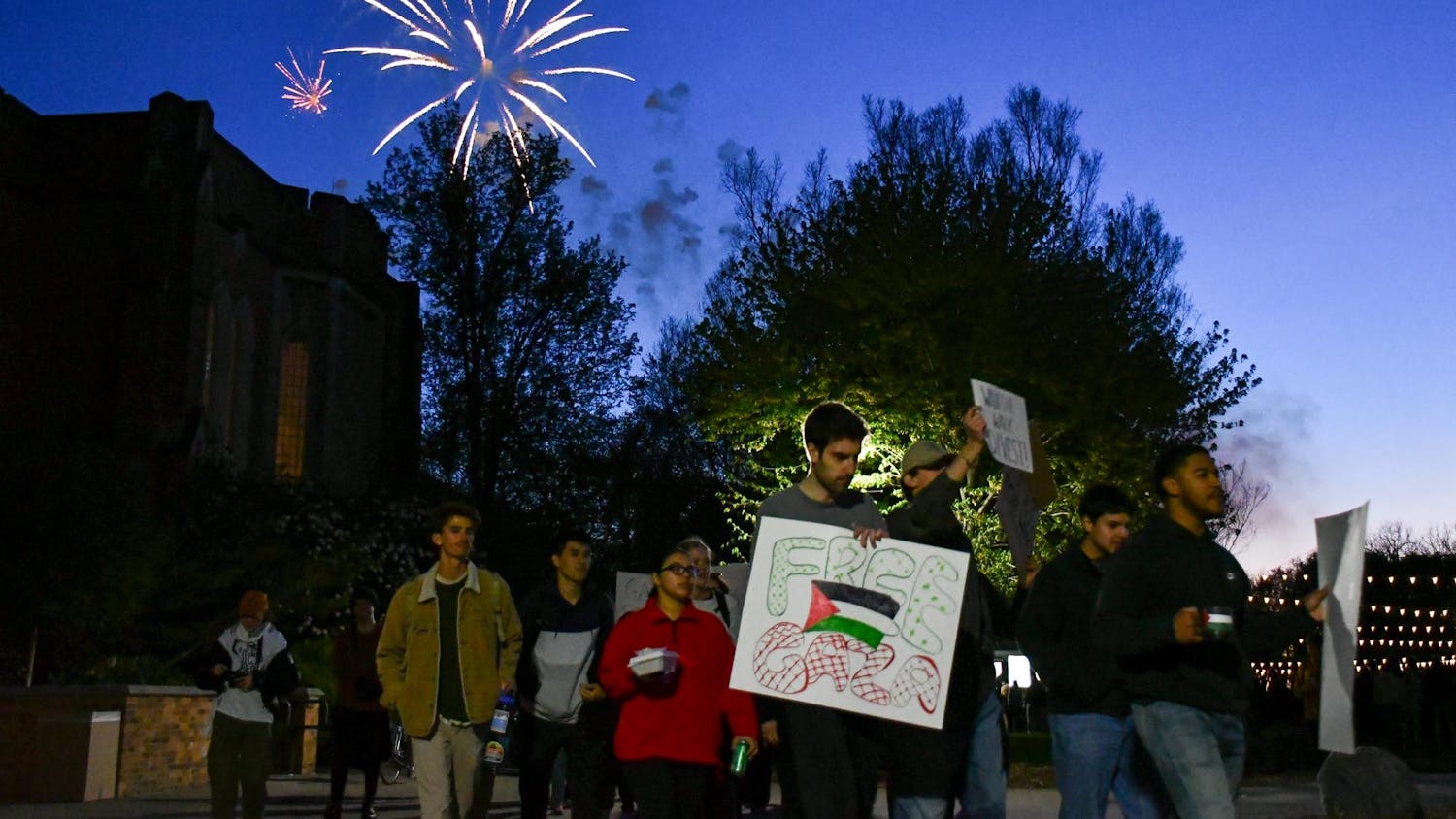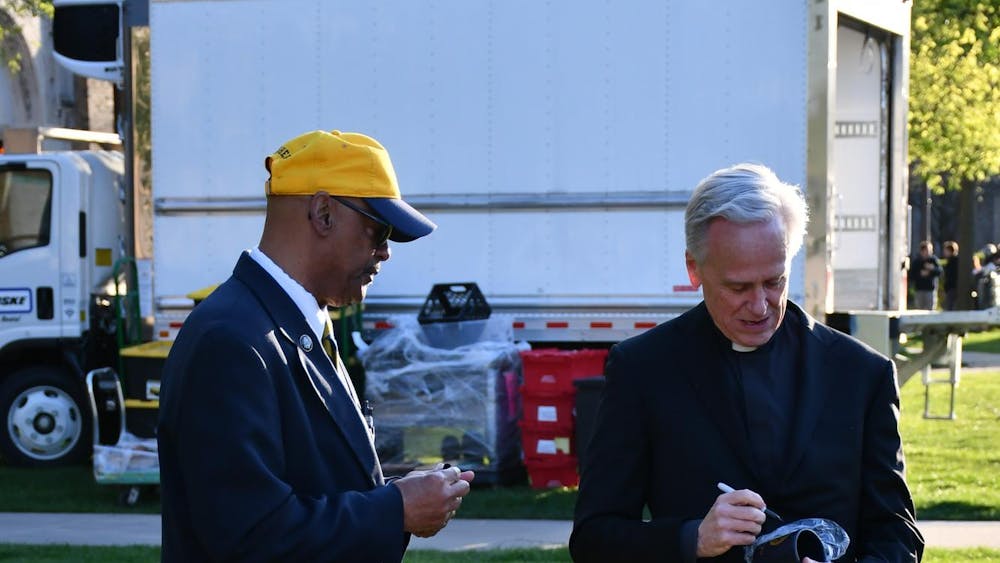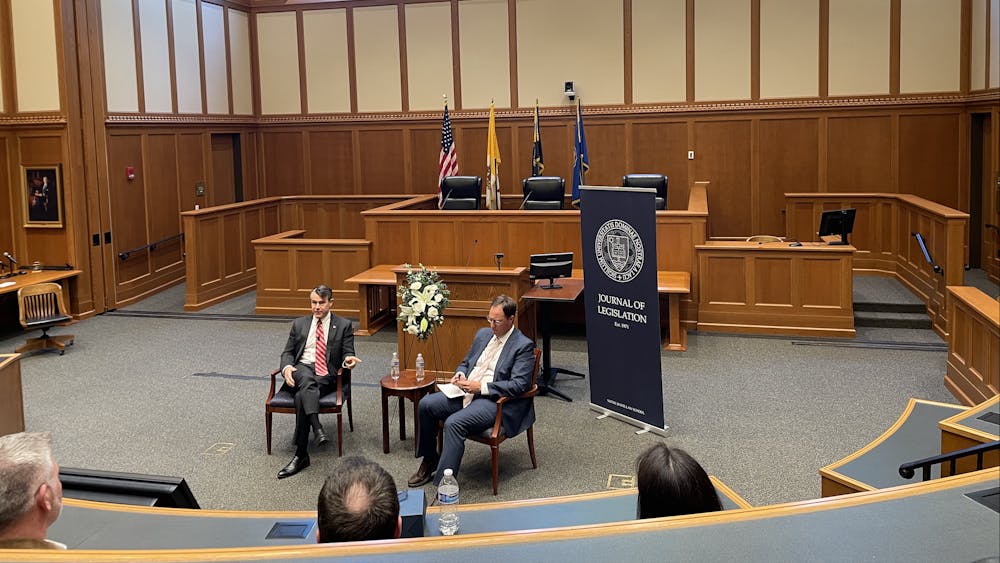After University President Emeritus Fr. Theodore Hesburgh died in 2015, the South Bend city council wanted to find a way to honor his memory, South Bend deputy director of public works Jitin Kain said. So it decided to install a statue of Hesburgh in the city.
“ … The mayor’s office began speaking with the University about honoring his legacy, and the idea that came forward [for the statue] was the picture of him and Dr. King that has been used on campus a lot,” Kain said. “It’s very known. The idea was, ‘Can we make that into a life-size monument?’”
The picture — replicated in the LaFortune Student Center — depicts Hesburgh holding hands with Martin Luther King Jr. at a rally in Chicago while they sing “We Shall Overcome,” according to a University press release.
Fr. Hesburgh was known for his involvement with the Civil Rights Act of 1964, which he helped to engineer, former Notre Dame men’s basketball coach Digger Phelps said.
“There were three men from the South and three men from the North — including Fr. Hesburgh — and they went up to the Land of Lakes in Wisconsin, where Notre Dame has a retreat place,” he said. “And that’s where after an afternoon of fishing, the six men … came up with ideas for the Civil Rights Act [and] took it to the White House to give to President Eisenhower.”
Professor Emeritus of American studies and journalism Robert Schmuhl, author of “Fifty Years with Father Hesburgh: On and Off the Record,” said Hesburgh played a critical role in the Civil Rights movement.
“Fr. Hesburgh was one of the original members of the U.S. Civil Rights Commission when it began its work in 1957,” he said in an email. “He served while four presidents were in the White House (from 1957 until 1972) and was named chairman of the Commission by Richard Nixon. That was a critical 15-year period in civil rights for this country, and Fr. Hesburgh was at the center of many of the actions and passions of this time.”
Though Hesburgh tended to concentrate his personal involvement in national and international affairs rather than in South Bend, his work still impacted the local community, Schmuhl said.
“Fr. Hesburgh viewed Notre Dame as a national — and international — university and as a result he tended to focus his attention and work on national and international affairs,” he said. “His appointments to various commissions and boards by American presidents and Popes reflected assignments of broad consequence with local implications. His service reverberated to encompass South Bend and the local area.”
The sculpture of Hesburgh and King was designed by local sculptor Tuck Langland and funded by the African American Community Fund, the University of Notre Dame, the Community Foundation of St. Joseph County, Arthur J. Decio, Dorene and Jerry Hammes, Jerry H. Mowbray, Great Lakes Capital, Visit South Bend Mishawaka and the Indiana Housing and Community Development Authority (IHCDA), Kain said.
“We knew we wanted to do more than just install the statue because we were also trying to activate the public plaza space,” Kain said. “So at that point we identified the need to fundraise a little more, to do some landscaping and the water feature which you see now in the plaza, tables and chairs and that part was done through a crowdfunding program called Patronicity.”
Kain said the city raised approximately $20,000 through Patronicity, which the IHCDA then matched with a grant. Fundraising, along with choosing a location for the statue, were the aspects of the project which he said required the most planning.
“But beyond that, you know, once the funding was in place, once the location was in place, we did have some challenges in getting contractors for the installation,” he said. “Because we have so much construction activity in our city, and this was a smaller project compared to some of the other work that’s happening in South Bend and on campus.”
Kain said the statue was constructed in Leighton Plaza on South Main Street, in order to create “a space for gathering.”
“We often see people who are walking by the plaza will stop and take their picture with the statue, but will also sit in the plaza space,” he said. “So the plaza, Leighton Plaza, was very under-utilized. Once we placed the statue in there, it’s really become more of a vibrant public space.”













